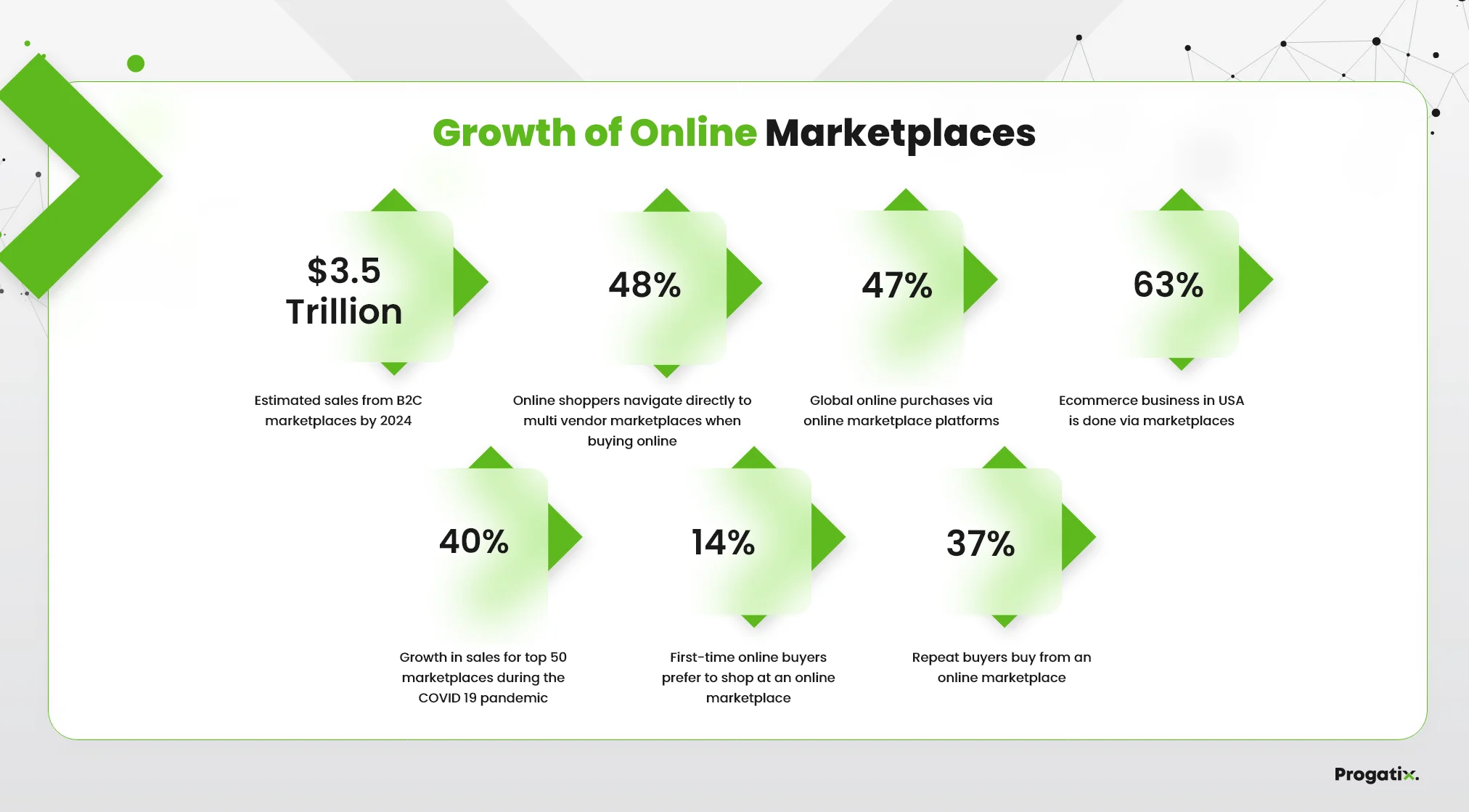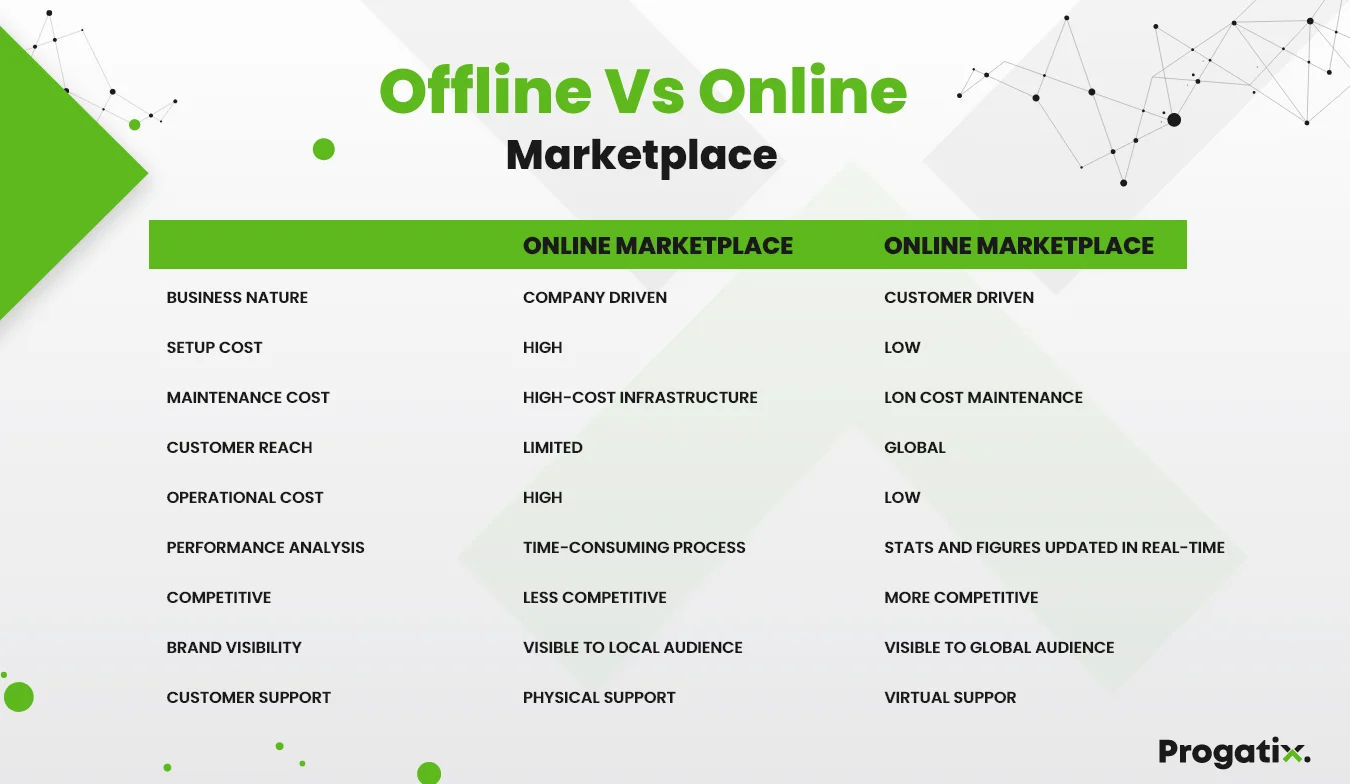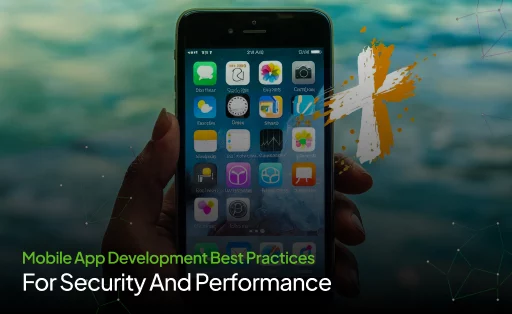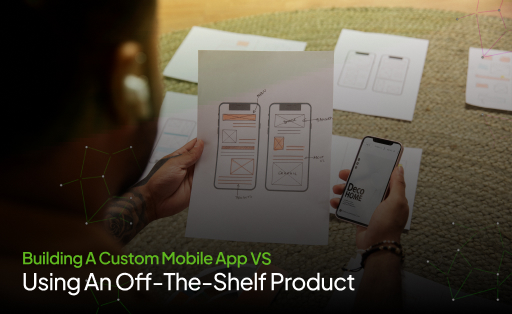What is the Marketplace Business Model? Business

Marketplaces have reconstruted the way we buy and sell products and services. From physically visiting stores with limited options to getting an opportunity to shop on a global scale is evidence of the tremendous growth and success of business models.
Since 2020, there has been a massive point in online marketplaces, with $3.5 trillion of scale in sales estimated from B2C marketplaces by the year 2024, and 47% of global online purchases are done through online marketplace platforms.
Source: storehippo
According to internet resources, 79% of Americans prefer online purchases, such as brands like Amazon’s own 12 million item inventories. Due to evolving customer demands, startups, and small businesses are required to invest in ideas that are updated and trending. If you are an entrepreneur and want to comprehend the online marketplace industry better before investing in it, then this blog is for you.
Overview
A business marketplace model is an eCommerce business providing a virtual space or simply an online platform that connects buyers and sellers for the exchange of goods and services. Marketplaces serve different industries, including services, retail, or rentals, besides focusing on B2B, B2C, or C2C transactions.
What is the Marketplace Business Model?
Consumers use the Internet widely these days. The Internet is widely used to shop for a lot of products online as it allows them to make purchases at ease and from their homes. However, this trend was aggravated during the coronavirus pandemic, when people were not safe to visit crowded public spaces for shopping.
The marketplace business model is referred to as a virtual space where sellers and buyers can communicate to buy and sell products and services. The marketplace is midway, which improves value by smoothing this connection through an exclusive platform.
Usually, the marketplace does not own any records or play any role in the actual order success. Even though the marketplace does not contribute to order fulfillment, it sets the ground rules that need to be monitored during order fulfillment. For example, the delivery times, modes of payment, refund policies, and other significant factors are made certain by the online marketplace.
There are several types of marketplace.
One prominent way of categorizing marketplaces is centered on the number of product groups or types accessible on the platform. For instance, a company like Amazon trades numerous kinds of products in its marketplace, and such business models are known as global marketplaces.
Conversely, there are various other online marketplaces where only single category-related products are sold, and such types of marketplaces are known as vertical marketplaces.
A third category of companies or marketplace selling numerous products related to each other or similar categories is known as a horizontal marketplace.
Types of Marketplace Business Models
Types of business models are as many as there are types of businesses itself. For instance, franchising, direct sales, advertising-based, and brick-and-mortar stores are all instances of traditional business models. There are hybrid models as well, including businesses combining internet retail with brick-and-mortar stores or with sporting organizations like the NBA.
Below are some of the most common types of business models, but the given examples might fall under multiple categories.
1. Retailer
The retailer model, the last entity besides a supply chain, is one of the common business models most people interact with. They usually buy finished goods from manufacturers or distributors and connect with customers directly.
Example: Costco Wholesale
2. Manufacturer
A manufacturer holds the responsibility for raw material sourcing and finished products by impacting internal labor, equipment, and machinery. A manufacturer might generate custom goods or highly replicated, mass-produced products besides selling goods to retailers, distributors, or customers directly or they can use the Custom Software Development Services to enhance manufacturing.
Example: Ford Motor Company
3. Subscription
Subscription-based business models aim to appeal to the population and persuade them to transform into long-time and loyal clients. This can be effectively done by offering a product requiring constant payment, usually in return for a stable duration of benefit. Apart from being essentially offered by digital companies for software access, subscription business models are also known for physical goods, including monthly reoccurring agriculture or producing subscription box deliveries.
Example: Spotify
4. Fee-for-Service
Instead of just being limited to the products sold, fee-for-service business models revolve around labor and providing services. A fee-for-service business model might charge an hourly rate or a fixed cost for a particular agreement. Fee-for-service companies are specialized and offer insights that cannot be seized with just common knowledge and require specific training.
Example: DLA Piper LLP
5. Freemium
Freemium business models persuade customers by offering them basic and limited-scope products. Then, accompanying the client using their service, the company makes efforts to transform them into a more premium and improved product requiring payment. Although a customer may hypothetically stay on freemium forever, a company goes on to display the benefit of becoming a permanent and upgraded member.
Example: LinkedIn/LinkedIn Premium
Some businesses can exist within multiple business model types for the same product at the same time. For instance, Spotify (a subscription-based model) also offers a premium version as well as a free version.
6. Marketplace
Marketplaces are rather straightforward: in the place for platform hosting for business to be directed, the marketplace obtains compensation. Although transactions can be done without a marketplace, this business model makes the transactions easier, faster, and safer.
Example: eBay
7. Bundling
If a company is concerned over the cost of drawing in a single customer, then they might try product bundling to sell multiple goods to a single client. Bundling makes the most of existing customers by allowing them to sell them different products. This can be motivated by pricing discount offers as a reward for buying multiple products.
Example: AT&T
8. Affiliate
Affiliate business models are built on the basis of marketing and the specific entity or person’s platform with a wide range. Companies pay an entity well to get promoted, and that entity often gets compensation as an alternative to their promotion. That compensation can either be a fixed payment, a sales percentage derived from their promotion, or both.
Example: social media influencers such as Zach King, Lele Pons, or Chiara Ferragni.
9. Razor Blade
Rightly named after the product that designed the model, this business model sells a robust product at a reasonable cost and then generates high-margin sales of that product’s disposable component. Also known as a “razor and blade model,” razor blade companies might give away expensive blade handles on the basis that consumers must continually buy razor blades for the longer run.
Example: HP (printers and ink)
“Tying” is an illegal razor blade model tactic that involves the purchase of an unrelated good rather than being able to buy a diverse and often needed good. For instance, imagine Gillette released a line of lotion and asked the customers to buy three bottles before they were permitted to buy disposable razor blades.
10. Reverse Razor Blade
As a substitute for relying on high-margin companion products, a reverse razor blade business model makes attempts to sell a high-margin product directly. Then, for using the product, low or free companion products are given. This model targets to promote that upfront sale, as the product’s advanced use is not highly beneficial.
Example: Apple (iPhones + applications)
11. Pay-As-You-Go
In spite of charging a fixed fee, some companies implement a pay-as-you-go business model where the charged amount depends on the quantity of product or service used. The company might set and charge a fixed fee to offer the service in addition to an amount that deviates each month based on its consumption.
Example: Utility companies
12. Brokerage
A brokerage business model allows buyers and sellers to connect by indirectly selling a good themselves. Brokerage companies often obtain a percentage of the amount paid during a deal completion. This model is commonly used in real estate and the construction/development industry.
13. Franchise
The franchise business model controls and manages existing business plans to develop and reproduce a company in different settings. Whether it is food, hardware, or fitness businesses, franchisers work with inbound franchisees for business financing, new location promotion, and operations supervision. In response, the franchisor earns a percentage of earnings from the franchisee.
Example: Domino’s Pizza
Start Advancing Your Custom Marketplace:
Consult Now for Our Software Development Services!
Difference between Offline vs. Online Marketplace Business Model
An offline marketplace is present at a physical location where buyers and sellers exchange services and goods, including street markets, brick-and-mortar stores, and trade shows. These offline or physical marketplaces have existed for centuries and carry on to play a vital role in commerce, specifically in advancing countries, for instance, with limited access to the Internet.
They allow buyers to see and touch products before making a purchase along with providing a sense of community to both buyers and sellers. However, offline marketplaces might be less appropriate than online marketplaces, often requiring buyers to transport to a precise location and might not have as varied a selection of services or products accessible.
Alternatively, the online marketplace model has much more room in terms of progress and successively operating the business. With low functioning and maintenance costs, it can spread to the global audience quickly.
Source: valueappz
The above-given table shows that running an offline store can be more costly and restrict customer reach. Building an online marketplace consumes less time and provides numerous other ways to unite with the global audience.
How do Online Marketplaces Work?
The online marketplace business model simplifies the buying and selling of services and goods completely over the Internet. Online marketplaces act as mid-way amid sellers and purchasers, providing a platform for them to sell and buy globally.
Below are the steps of how the online marketplace business model works:
1. Registration
The first step involves platform registration. Sellers and buyers register themselves on the marketplace for buying and selling products and services. To create an account, they often have to provide basic information such as name, email address, and verification documents.
2. Products and Services Listing
Once sellers get registered on the platform, they bring in the list of services and products they anticipate selling. Necessary details like images, product descriptions, prices, and shipping options are given with every product. This information is really important for keeping customers engaged.
3. Search and Discovery
After the products are listed in the marketplace, the customers are allowed to browse them. Customers are given access to search for a specific product or browse numerous categories and apply filters to find relevant listings. It is only online marketplaces that provide innovative search filters to purchasers for quickly getting to the desired products.
4. Purchase
Once the buyer has their hands on the required products, they can add them to the cart and continue to checkout. Marketplace business models usually provide secure payment options, including credit cards, debit cards, money transfer apps, and other digital payment systems. For placing orders, customers must provide details like name, email address, complete address, etc.
5. Transaction Completion
After placing the order, the seller gets a notification through the marketplace. Sellers can then continue to arrange the order, including safe packaging. The platform controls all the transactions, including order confirmation, payment processing, and scheduling.
6. Communication
Buyers and sellers are allowed to collaborate with each other over the platform in case of any assistance. They can ask queries, negotiate prices, and assemble shipping or delivery information. Additionally, customers can also contact the sellers if their products are not delivered or damaged.
7. Reviews and Ratings
Buyers can provide feedback once they have collected the product. The ordered products and delivered services are given ratings and reviews over the marketplace model, which can further assist with product quality improvement and extended services.
How to Create a Business Model
There is no “one size fits all” thing when making a business model. Different professionals might provide suggestions involving different steps when building a business and developing your business model. The following are some of the wide-ranging steps one can take to create a plan:
1. Classify your audience
Most business model plans begin either with describing problems or recognizing the audience and target market. A strong business model comprehends the specific target and modifies your product, messaging, and method of connecting with a particular audience accordingly.
2. Explain the problem
Apart from understanding your audience, you must know what problem you are trying to solve. For instance, a hardware company sells home repair products, and a restaurant feeds the community. Without an issue or a need, your business can struggle to find its stability because if there isn’t a demand for your services or products, then your business won’t grow.
3. Recognize your offerings
With your audience and problem in mind, consider what you are capable of offering, including what your interests in selling products are and whether your expertise aligns with the product or not. In this stage of the business model, the product is twisted to adjust according to the market requirements and your ability to provide.
4. Document your requirements
After your product selection, consider the challenges your company can and will face, including product-centered and operational challenges. Also, make sure to document each of these requirements to re-consider your decision to launch in the future.
5. Find key partners
Most businesses impact other partners in encouraging company success. For instance, a wedding planner may counterfeit relationships with caterers, venues, florists, and tailors to improve their offerings. For manufacturers, look at who will provide your materials and what type of relationship you both share.
6. Set monetization solutions
Until now, we haven’t talked about how a company can make money with it because a business model isn’t complete until it sorts the ways of making money, which includes the strategy or strategies selection for defining your business model type. This can be a type you had in mind, but after looking at your client’s needs, a different type can make more sense.
7. Test your model
When your plan is completed, execute test surveys or soft launches. Inquire how people would feel about your prices for your services. Offer discounts to new customers for providing feedback and reviews for services and products. You can always modify your business model at any point, but you must always consider using the market’s direct feedback when doing so.
Want to create your digital marketplace? Contact Progatix to start working on the best marketplace business model that fits your business by fulfilling your business-unique requirements. Progatix will not only listen to your idea but also provide you tips on how to bring it about and surface high-quality Minimum Viable Product (MVP).




 Let's Discuss Your Tech Solutions
Let's Discuss Your Tech Solutions 






